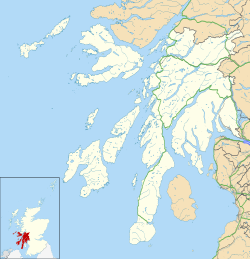Sandbank
| |
|---|---|
 Looking southeast along the A815 in Sandbank | |
Location within Argyll and Bute | |
| Population | 1,320 (2020) [1] |
| OS grid reference | NS 163 802 |
| Council area |
|
| Lieutenancy area |
|
| Country | Scotland |
| Sovereign state | United Kingdom |
| Post town | DUNOON, ARGYLL |
| Postcode district | PA23 |
| Dialling code | 01369 |
| Police | Scotland |
| Fire | Scottish |
| Ambulance | Scottish |
| UK Parliament | |
| Scottish Parliament | |
Sandbank (Scottish Gaelic : an Oitir or Taigh a' Chladaich) [2] is a village in Argyll and Bute, Scotland. It is located 2.5 miles (4 kilometres) north of Dunoon on the coastal A815 (low road) or the inland A885 (high road). It sits on the southern shore of the Holy Loch, a sea loch of the Firth of Clyde. [3]





